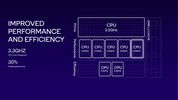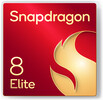Qualcomm Snapdragon 8 Gen 3 vs Qualcomm Snapdragon 8 Elite
Qualcomm Snapdragon 8 Gen 3
► remove from comparison
The Qualcomm Snapdragon 8 Gen. 3 (SM8650-AB) mobile platform is a high end SoC for Android-based smartphones and tablets.
The cryo-CPU is based on ARM's v9.2 architecture and consists of three clusters: The first includes a fast prime core (ARM Cortex-X4) with up to 3.3 GHz. The second consists of three power cores with up to 3.2 GHz and two additional cores clocking at up to 3.0 GHz (all Cortex-A720). The efficiency cluster consists of two power-saving cores (Cortex-A520) that operate at up to 2.3 GHz. The SoC uses the integrated Adreno 750 for graphics acceleration.
Compared to the Snapdragon 8 Gen. 2, Qualcomm promises a 25 percent higher GPU clock rate, whose power consumption is said to have been reduced by 25 percent at the same time. Similarly, the CPU's performance is announced to be now a whopping 30 per cent faster and requires 20 per cent less power.
A special focus is also placed on machine learning (AI). The integrated Hexagon NPU is 98% faster than its predecessor and promises a 40% improvement in efficiency. Qualcomm's AI engine is the first to support multimodal generative AI models, including LLM, LVM and ASR, and can process up to 10 trillion parameters directly on the SoC. Image manipulation is said to be possible within fractions of a second. In addition, the NPU of the Snapdragon 8 Gen 3 is also capable of INT4 and Meta Llama 2.
Also back on board is Snapdragon Sight, Qualcomm's brand for camera functions. In addition to Ultra HDR, Dolby HDR is also supported for photos. Photos can now be enhanced by generative AI models and with the Video Magic Eraser (ArcSoft), unwanted people and objects can also be removed from videos. In addition, the ISP is able to distinguish real photos from AI-generated content. This is again a triple ISP (Image Signal Processor), which works with 18 bits and up to 12 layers.
The integrated Snapdragon X75 Modem-RF 5G system allows simultaneous transfers of 5G-mmWave and 5G-Sub6, enabling data rates of up to 10 GBit/s in download and up to 3.5 GBit/s in upload. In addition, the modem is able to support all known 5G bands worldwide. Qualcomm's FastConnect 7800 is once again responsible for local communication, which can handle Bluetooth 5.4 with LE Audio and Wi-Fi 7, among other things.
The SoC is manufactured by TSMC in a 4 nm process.
Qualcomm Snapdragon 8 Elite
► remove from comparison
The Snapdragon 8 Elite (SM8750-AB) is a high-end SoC for flagship smartphones and tablets in 2025 and the top product from the US manufacturer.
For the first time, Qualcomm is using CPU cores in smartphone SoCs that are not adapted ARM designs, but have their own ARM-based architecture: The manufacturer calls the processor part a second-generation Oryon CPU.
The previously used efficiency cores are no longer required and their task is taken over by the performance cores which, according to the manufacturer, are now flexible and efficient enough for this purpose.
There are a total of 2 prime cores with up to 4.32 GHz for complex tasks, which according to Qualcomm can also be overclocked at times. there are also 6 performance cores for less demanding tasks, which clock at up to 3.53 GHz.
Both processor clusters have 12 MB of L2 cache, which should offer low latency despite its size. Next up in the cache hirachy is a 8 MB SLC L3 cache and finally four 16 Bit LPDDR5x memory controllers to the main memory.
A new Adreno 830, which has also been redesigned, is used as the GPU. Thanks to the so-called "sliced architecture", it now offers three processing cores with a clock speed of up to 1.1 GHz.
Compared to the Snapdragon 8 Gen. 3, Qualcomm promises a processor speed advantage of up to 45% and similar efficiency gains. With the GPU, performance gains of up to 40% should be possible.
The focus for the 2025 flagship smartphones is also on AI. The new Hexagon NPU should offer 45% more performance compared to its predecessor and also work 45% more efficiently. There is also broad support for multimodal generative AI models.
The three ISPs have also been revised and are now called Spectra AI ISP. They can handle data from up to 3 48-megapixel cameras simultaneously. A resolution of up to 320 megapixels is possible with a single camera. Unlimited semantic segmentation is possible with 4K images, meaning that as many different layers and objects can be distinguished as there are in the image. This allows automatic photo optimization to be improved. In addition, the NPU now has direct access to the RAW data from the sensors for the first time.
The integrated Snapdragon X80 Modem-RF 5G system allows simultaneous transfers of 5G-mmWave and 5G-Sub6, enabling data rates of up to 10 GBit/s in download and up to 3.5 GBit/s in upload. The modem is also able to support all globally known 5G bands. Qualcomm's FastConnect 7900, which supports Bluetooth 6.0 and Wi-Fi 7, is responsible for local communication.
The SoC is manufactured at TSMC using the state of the art 3 nm process.
| Model | Qualcomm Snapdragon 8 Gen 3 | Qualcomm Snapdragon 8 Elite | ||||||||||||||||||||
| Codename | Cortex-X4 / A720 / A720 / A520 (Kryo) | Oryon Gen 2 | ||||||||||||||||||||
| Series | Qualcomm Snapdragon 8 | Qualcomm Snapdragon 8 | ||||||||||||||||||||
| Series: Snapdragon 8 Oryon Gen 2 |
|
| ||||||||||||||||||||
| Clock | 2300 - 3300 MHz | 3530 - 4320 MHz | ||||||||||||||||||||
| L3 Cache | 8 MB | 8 MB | ||||||||||||||||||||
| Cores / Threads | 8 / 8 1 x 3.3 GHz ARM Cortex-X4 3 x 3.2 GHz ARM Cortex-A720 2 x 3.0 GHz ARM Cortex-A720 2 x 2.3 GHz ARM Cortex-A520 | 8 / 8 3 x 2 x 4.3 GHz Qualcomm Oryon Gen 2 Prime 6 x 3.5 GHz Qualcomm Oryon Gen 2 Performance | ||||||||||||||||||||
| Technology | 4 nm | 3 nm | ||||||||||||||||||||
| Features | Adreno GPU, Spectra ISP, Hexagon, X70 5G Modem, FastConnect 7800 Wi-Fi 7, LPDDR5x 4800 MHz Memory Controller | Adreno GPU, Spectra ISP, Hexagon, X80 5G Modem, Wi-Fi 7, LPDDR5x 4800 | ||||||||||||||||||||
| iGPU | Qualcomm Adreno 750 ( - 903 MHz) | Qualcomm Adreno 830 ( - 1100 MHz) | ||||||||||||||||||||
| Architecture | ARM v9 | ARM | ||||||||||||||||||||
| Announced | ||||||||||||||||||||||
| Manufacturer | www.qualcomm.com | www.qualcomm.com | ||||||||||||||||||||
| L2 Cache | 12 MB |
Benchmarks
Average Benchmarks Qualcomm Snapdragon 8 Gen 3 → 100% n=22
Average Benchmarks Qualcomm Snapdragon 8 Elite → 138% n=22
* Smaller numbers mean a higher performance
1 This benchmark is not used for the average calculation





